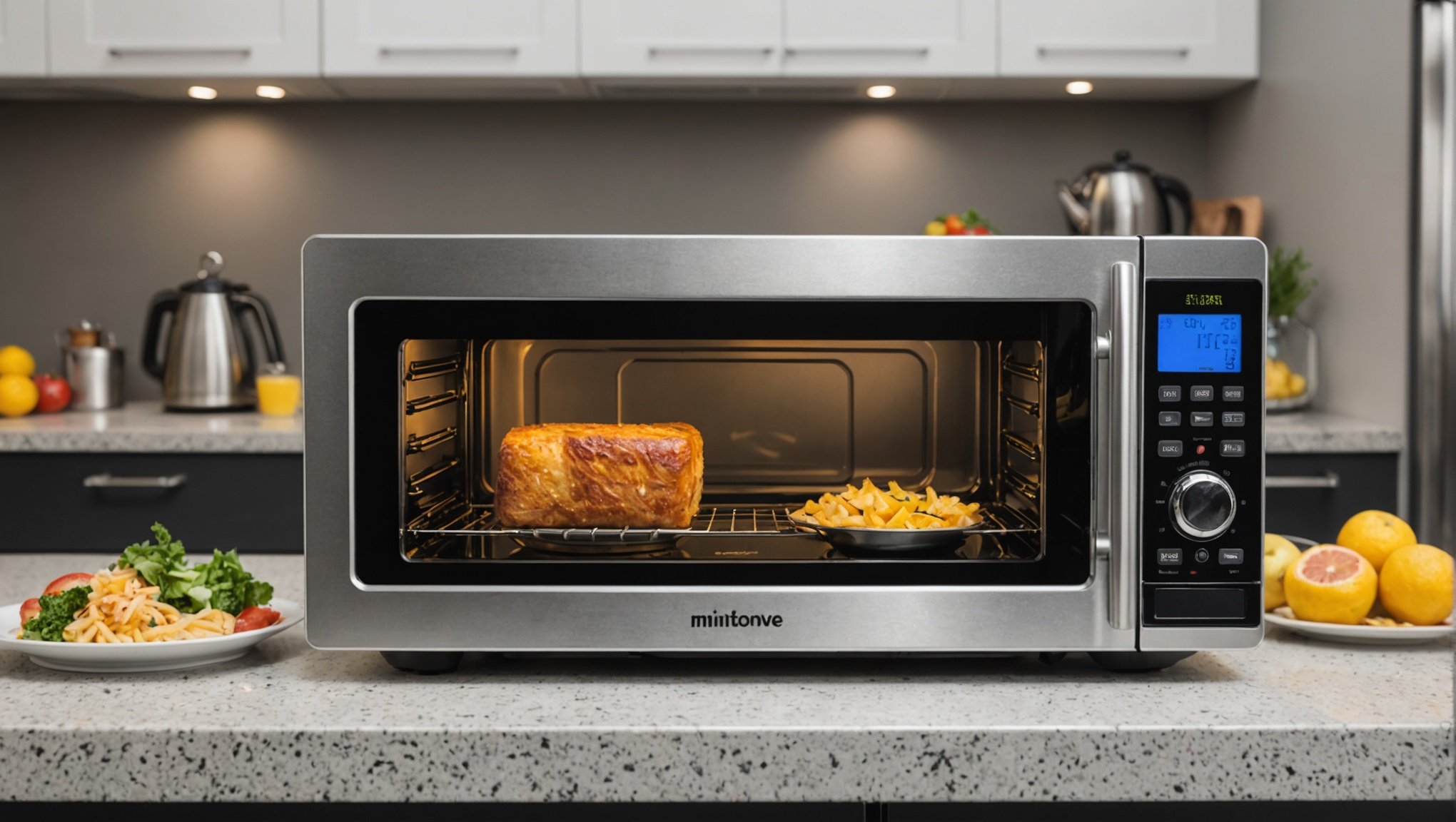Selecting a smart microwave involves more than just choosing a convenient appliance. Concerns about radiation exposure can influence your decision. Understanding technology and safety features helps you make informed choices. This guide offers practical tips to identify microwaves that minimize radiation output while enhancing cooking efficiency. Discover how to balance modern convenience with safety, ensuring a worry-free cooking experience. Your health and peace of mind are paramount, and the right choices can make all the difference.
Understanding Smart Microwaves and Radiation
Smart microwaves have revolutionised the way we cook by incorporating advanced technologies such as Wi-Fi connectivity, voice control, and sensor cooking. These features allow for more precise cooking and the convenience of controlling the appliance remotely. However, it is important to understand the types of radiation emitted by these devices.
This might interest you : Maximize Kitchen Space and Boost Efficiency with Revolving Spice Racks: A Game-Changer for Home Chefs!
Microwaves emit non-ionizing radiation, which is different from ionizing radiation found in X-rays and gamma rays. Non-ionizing radiation is generally considered safe as it lacks the energy to remove tightly bound electrons. This type of radiation is used to heat food by causing water molecules to vibrate, producing heat.
Despite the general safety of non-ionizing radiation, some health concerns exist. Prolonged exposure to microwave radiation, although unlikely, could potentially lead to thermal effects, which are the result of heating body tissues. It is crucial to follow safety guidelines, such as not using a damaged microwave and ensuring the door seals properly, to minimise any risks.
Topic to read : Maximize Kitchen Space and Boost Efficiency with Revolving Spice Racks: A Game-Changer for Home Chefs!
Understanding the functionalities and radiation types of smart microwaves can help users make informed decisions while enjoying the benefits of these innovative appliances.
Safety Standards and Certifications
In the realm of microwave safety, understanding the established standards and certifications is crucial. Regulatory bodies like the FDA set rigorous guidelines to ensure that microwaves operate safely. These regulations primarily focus on limiting radiation emissions and ensuring that the device’s construction prevents any leakage that could pose health risks.
When purchasing a microwave, it is vital to check for health certifications such as UL (Underwriters Laboratories) or ETL (Electrical Testing Laboratories). These certifications indicate that the microwave has been tested and meets specific safety criteria. A certified microwave provides peace of mind, assuring users that the device has passed stringent safety evaluations.
Regulatory bodies play a pivotal role in maintaining microwave safety by enforcing compliance with safety standards. They conduct regular inspections and mandate that manufacturers adhere to guidelines that protect consumers from potential hazards. By understanding these safety standards and certifications, users can make informed decisions and select appliances that prioritise their well-being.
Features to Consider for Safety
When choosing a smart microwave, it’s important to prioritise safety features. These features ensure that the appliance operates safely and efficiently, minimising potential risks.
Essential Safety Features
- Child Lock: Prevents accidental operation by children, ensuring their safety.
- Automatic Shut-Off: Turns off the microwave if it overheats or runs for too long, preventing fires.
Smart Technology and Safety
Smart microwaves often incorporate advanced technologies that enhance safety. For instance, sensor cooking adjusts power levels and cooking time based on the food’s moisture and temperature, reducing the risk of overheating. Additionally, voice control and Wi-Fi connectivity allow users to monitor and control the appliance remotely, offering convenience and added safety.
Comparing Smart Technologies
Different smart technologies have varying safety implications. For example, while voice control provides hands-free operation, it requires secure connectivity to prevent unauthorised access. On the other hand, sensor cooking ensures precise cooking but relies on accurate calibration to function safely. Understanding these technologies can help users choose a microwave that best suits their safety needs.
By focusing on these microwave features, consumers can enjoy the benefits of smart technology while ensuring a safe cooking environment.
Proper Usage Techniques to Minimize Exposure
Understanding microwave usage tips is essential for ensuring safety and minimising radiation exposure. By adopting safe cooking practices, users can enjoy the convenience of smart microwaves without compromising health.
Best practices include maintaining a safe distance from the microwave while it is operating. Although non-ionizing radiation is generally safe, standing a few feet away can reduce any potential exposure. Additionally, regularly inspecting the microwave for damage, especially around the door seal, ensures that no radiation leaks occur.
Positioning the microwave properly in the kitchen is also crucial. It should be placed at a height that is convenient but not too close to eye level, reducing direct exposure to the face. Ensure that there is adequate ventilation around the appliance to prevent overheating.
Using microwave-safe containers is vital. Only use containers labeled as microwave-safe, as others may release harmful chemicals or melt, leading to food contamination. Glass, ceramic, and certain plastics are typically safe options. Avoid using metal containers entirely, as they can cause sparks and damage the microwave.
By incorporating these techniques, users can safely enjoy the benefits of their smart microwaves.
Common Myths About Microwave Radiation
In the realm of microwave myths, misinformation often leads to unnecessary concerns about radiation safety. A prevalent myth is that microwaves make food radioactive. In reality, microwaves use non-ionizing radiation, which is safe and does not alter the atomic structure of food. This is fundamentally different from ionizing radiation used in X-rays, which can cause harm.
Another misconception is that microwave cooking significantly depletes nutrients in food. While some nutrient loss occurs, it is comparable to other cooking methods. In fact, microwaving can preserve more nutrients due to shorter cooking times and minimal water usage.
Concerns about microwaves leaking harmful radiation are also widespread. Modern microwaves are designed with safety features that prevent radiation leakage, such as secure door seals. Regular maintenance ensures these features function effectively, maintaining safety standards.
Understanding these myths helps in addressing unfounded fears and promotes informed usage of microwaves. By distinguishing between fact and fiction, consumers can confidently enjoy the convenience and efficiency that microwaves offer, without undue worry about radiation or nutritional concerns.
Recommended Smart Microwaves for Health-Conscious Users
For those prioritising health and safety, selecting the best smart microwaves involves considering brands and models that emphasise minimal radiation exposure. Several health-focused brands have innovated to ensure their appliances meet stringent safety standards while offering advanced features.
Top Smart Microwave Recommendations
- Panasonic NN-SN966S: Known for its inverter technology, this model ensures even cooking and retains more nutrients by using consistent power levels, reducing cooking time and energy consumption.
- Toshiba EM131A5C-BS: This microwave features sensor cooking that automatically adjusts power and time, enhancing safety by preventing overheating and ensuring food is cooked thoroughly without excessive radiation exposure.
- Breville BMO850BSS: With its Element IQ system, this appliance provides precise control over cooking, allowing users to customise settings for healthier meal preparation.
Expert Reviews and User Testimonials
Experts praise these models for their innovative safety features and efficiency. Users report satisfaction with the reduced cooking times and nutrient retention, attributing these benefits to the advanced technologies employed by these health-focused brands. By choosing these recommended smart microwaves, users can enjoy convenience without compromising on safety.
Ongoing Research and Developments in Microwave Technology
Current microwave research delves into understanding the health impacts of microwave radiation. Scientists are investigating the long-term effects of exposure, focusing on how technology advances can mitigate any potential risks. This research aims to ensure that microwave ovens remain a safe cooking option.
Innovations in smart microwave technology are enhancing safety features. For instance, new models incorporate advanced sensors that adjust cooking parameters automatically, reducing the risk of overheating. These safety improvements are crucial, as they minimise the chance of accidental burns or fires.
Looking ahead, future trends in microwave design are increasingly focused on user safety. Developers are exploring materials that better contain radiation and features that provide real-time safety alerts. The aim is to create appliances that not only cook efficiently but also prioritise the well-being of users. As these technologies evolve, consumers can expect microwaves that offer both convenience and peace of mind.
Resources for Further Information
For those seeking comprehensive microwave safety resources, several trusted sources offer valuable insights. Educational materials from health organisations such as the World Health Organization (WHO) and the Food and Drug Administration (FDA) provide guidelines on safe microwave usage. These resources often include detailed instructions on proper handling, maintenance, and the importance of using microwave-safe containers.
Access to expert advice can further enhance understanding. Consumer reports and reviews from reputable platforms offer insights into the latest smart microwave models, focusing on safety features and user experiences. These reports often highlight models that excel in safety standards, providing a basis for informed purchasing decisions.
Additionally, online forums and communities dedicated to appliance safety can be a treasure trove of practical tips and shared experiences. Engaging with these platforms allows users to ask questions and receive answers from both experts and fellow consumers, fostering a community of informed users. By leveraging these resources, individuals can stay updated on best practices and innovations in microwave safety.












